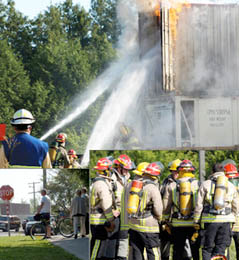
15 July 2009
Train Hauling Cheetos Catches Fire in Bolton
| |

Pieces of flaming debris fall from the open doors of the
freight car as flames flare out the top and thick smoke billows, engulfing firefighters. Civilians stop to look on (bottom left) as
firefighters battle this blaze that, while quickly extinguished, took some group planning (right).
|
Bolton Ontario - At least burning Cheetos aren't
considered hazardous material, despite their radioactive orange colour.
Caledon Fire and Emergency Services attended the train tracks near Ellwood Drive West and Station Road on Thursday,
9 Jul 2009 at 3:54 p.m. after reports of a "car fire".
As it turned out, the car was actually a train car, and its contents of foodstuffs was on fire, with flames and smoke visible from the
double-stacked freight when firefighters arrived.
The flaming car contained Cheetos in the top and Haagen-Dazs ice cream in the bottom, but three cars to the west and
eight cars to the east did contain hazardous products.
Despite the presence of hazardous material on the train though, there was never a risk.
"The type of temperatures generated by this fire, even if they were free burning, would have had no impact on the other
cars," said Caledon Fire Chief Brad Bigrigg.
 The hazardous cars were quite a ways down the line in either direction, and rail crews were very quick and efficient about separating
the train. "I was more than pleased and satisfied by the conduct of the railway crew."
The hazardous cars were quite a ways down the line in either direction, and rail crews were very quick and efficient about separating
the train. "I was more than pleased and satisfied by the conduct of the railway crew."
Canadian Pacific Railway staff confirmed that all traffic on the rail lines was shut down and worked with Caledon Fire teams to
separate the affected freight car from the rest of the 94 car, two-engine train while other teams of firefighters
commenced an offensive attack to prevent the flames from spreading.
Once the car was separated firefighters were able to douse it with water and open the doors, causing flames to flare up, but allowing
the team to knock down the fire in the two freight containers.
There were several challenges posed by the "extraordinary" nature of this fire. "The very first challenge is that we're
right on a main rail line, so all rail traffic had to be stopped," said Bigrigg.
Other challenges included accessing the train and having to access water from Ellwood Drive and run hoses to the rail tracks.
"My biggest fear was that someone would get hurt working around the train, not actually from the fire."
Rail and Fire crews moved quickly to isolate the train and give firefighters more access and minimize risk. "The railways were
exceptional to work with... they did exactly what we had been taught that they would do in the event of an emergency. They had all the
answers when we asked the questions and we don't always get that," said Bigrigg, adding that working with the rail crews was
"refreshing and reassuring".
"The second part was getting sufficient people and sufficient water," explained the Fire Chief.
The fire was detected around 4 p.m. when there were few available volunteer firefighters. "They would be going to work and coming
home from work and not actually in Bolton."
But the most hazardous part of the operation, according to Bigrigg, and probably the most dramatic to watch, was the opening of the
freight doors.
"It was very hot inside there, there was lots of smoke and as soon as it got the fresh air from opening the doors in took right
off," he explained.
Aside from the heat and the flaring flames, there was the danger of the unknown - not knowing how the cargo was sitting.
Pieces of flaming boxes and cargo fell when the doors were opened.
"It's only Cheetos, but had it been something else there was an opportunity for firefighters to be injured."
It took approximately 90 minutes to extinguish the flames.
It's believed that the train was instructed to stop where it was because of an accident on the rail line in Alliston, and that rail
crews may have discovered the fire while doing a routine check.
"We believe that it may have started in the bottom car and spread to the top car, but the bulk of the damage was done to the top
car, which would have been the Cheetos car," said Bigrigg.
No injuries were reported as a result of the incident, and no evacuation was necessary.
Some area residents came by to watch the firefighters work, and as a result of traffic re-routing Highway 50 was backed
up to the top of the south hill, at times past the Ellwood Drive and Highway 50 intersection.
"There wasn't too much interruption to the community, and we're always mindful of that, and we're mindful of the economy by not
putting people out of business by closing roads or closing the rail line," said Bigrigg.
Once the fire was extinguished the train was removed from the main tracks to a nearby property with a loading track. This allowed
firefighters to gain access to the interior of the containers with the assistance of heavy equipment provided by a private contracting
firm. Access crews were able to ensure the contents of the car was fully extinguished.
The cause of the fire is still under investigation and damage costs are estimated at $100,000.
Bolton, Palgrave, and Snelgrove fire stations responded, as well as Peel EMS, Caledon OPP, Canadian Pacific Police, Canadian Pacific
staff, a private excavating firm, and the Ministry of Environment.
The cause of the fire is still under investigation, but Caledon Fire and Emergency Services will be recouping costs by sending CP Rail
a bill, and decisions will be made from there.
Heather Abrey.
|
|